Almost no one buys from your website on the first visit. It takes multiple interactions.
The onus is on you to create an opportunity for your visitors to come back and interact with your brand.
How do you do that?
Blog into oblivion?
Spam social media?
Create awesome videos?
No, not exactly.
If you said lead magnets then you are, of course, right. All the other things may make them happy when they arrive. It’s the emails you send that keep them coming back.
The days of throwing up a newsletter subscription form in the sidebar are long gone. Not only are people blind to your right column (ours too), they’re not interested in your newsletter.
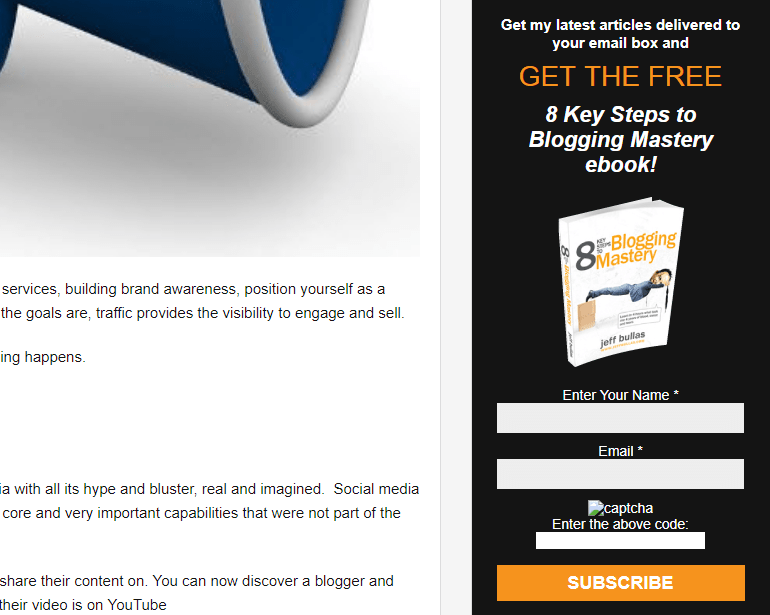
What’s an enterprising individual like you to do?
The answer, though simple, isn’t easy. Create compelling lead magnets.
A lead magnet is easy to create. A compelling lead magnet is much harder. That’s what this post is all about so let’s dive in.
Tip: here’s an idea you just might not’ve tried yet—offer an email finder tool as a lead magnet. It’s super handy for people looking to connect with new business contacts, and in return, you get their email. Cool, right?
Table of Contents
So really, what are lead magnets
There are a few definitions floating around the web. They’re complicated. A lead magnet, at its core, is simple.
Lead magnet – anything you offer your prospects in exchange for their contact information.

You need contact information to arrive at your most important goals. How would you tell your visitors about the awesome course, new products, your best book, and the latest blog post without being able to contact them?
You can’t.
The sheer variation of how to present your lead magnet is astounding. You can create dedicated landing pages, lightbox pop-ups, inline forms, and so much more.
Look back at the definition above. The operative word there is ANYTHING. Now, some things are more effective than others. Remember the newsletter subscription in your right sidebar? Yea, that’s not going to cut it.
Your lead magnet should do one of two things:
- Solve a pressing problem/gives immediate value
- Solves a long-term problem/gives long-term value.
Let’s look at a few of the most effective types of lead magnets.
Types of lead magnet you should be using
Each type of lead magnet is focused on different parts of your funnel.
Without going into too much detail, there are three parts to every funnel:
- Top of funnel. This is where you convert casual visitors to leads.
- Middle of the funnel. This is where you determine which leads are most interested in what you have to offer.
- Bottom of the funnel. This is where the money is made. Prospects at the bottom of your funnel are pushed towards making a purchase or trying your product in some way.
To have an effective funnel, your lead magnets and their messages need to match your prospect’s level of awareness. The level of awareness, to a large extent, determines where they are in your funnel.
Here are three types of lead magnets you can use at each stage of your funnel.
Top of funnel lead magnets
- Cheatsheet
- Checklist
- Ebooks/guides
Middle of the funnel lead magnets
- Case studies
- Webinar
- Calculator
Bottom of the funnel lead magnets
- Free consultation
- Comparison
- Discount codes
This classification is important. Like really important. You don’t want to use a bottom of the funnel lead magnet for a top of funnel prospect. They won’t bite. Would you book a free consultation when you barely know what you want?
Of course, you wouldn’t.
If you’re ready to buy are you interested in cheat sheets? No, you want to make sure the price and features are up to scratch.
Let’s get to the reason why you’re here – how to create compelling lead magnets.
How to create lead magnets that move your brand forward
The process for creating lead magnets, like most things in life, isn’t difficult. Once you have the framework, you can pump them out like clockwork. If you don’t have it, you’ll be scratching your head wondering what to do.
We’ve broken it down into a series of steps you can follow no matter what you decide to make.
Get in your prospects head
Unless you’re creating post-specific lead magnets, you’ll need to do a bit of soul searching to find what will work. We’ll look at two of the fastest ways.
- What’s already doing well in your market?
We don’t have access to the lead magnets which are working well for your competitors. People tend to hold their cards close to their chest for obvious reasons. There is a search engine that will tell you what a lot of people are already paying for.
Sounds too good to be true right? You probably already use it.
Amazon is one of the largest search engines in the world. It’s exclusive to product searches. It’s a treasure trove of competitive intelligence. We’re interested in the book section.
There’s a section for almost any category imaginable. If your niche isn’t represented here, consider choosing a different focus for your website #imjustsaying.
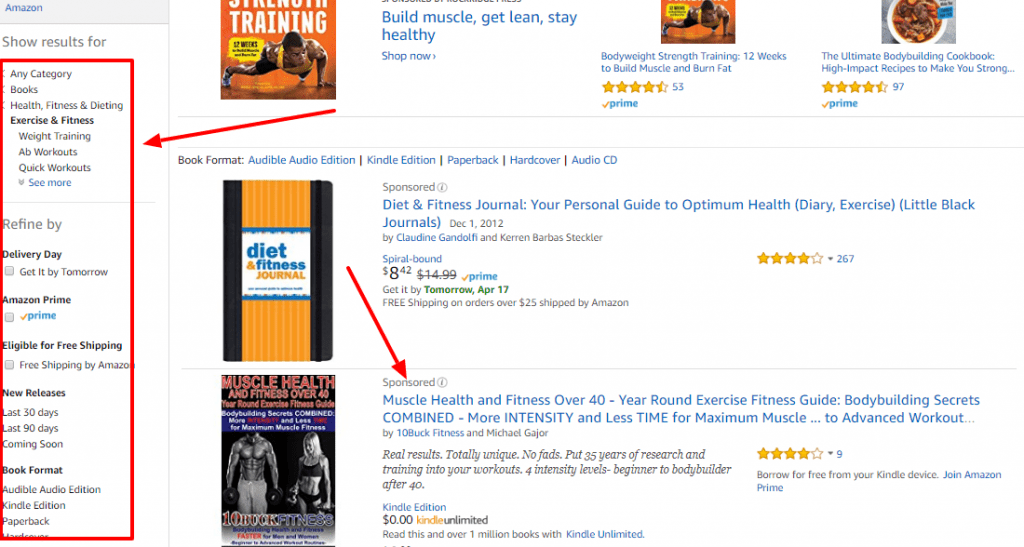
In the above screenshot, I searched for fitness. Then, I used the options to the left to adjust my search results by category and popularity.
The first few results are sponsored so I ignored them. Below is where I can start to get insights into what’s working right now.
Don’t only look at the number of four and five-star reviews a book has. Dive into the comments to understand what people are happy about and what’s lacking. The people who want something extra are telling you about a gap in the market AKA the perfect lead magnet for your business.
If KyLeads was a fitness brand, we’d have a lot of options for lead magnets through this exercise. Here are some of the comments people left:

The reader liked the first half of the book because it dealt with nutrition and practical insights. The second half was too difficult because the process too involved. He cites the example of squatting; there were too many things to keep in mind at once.
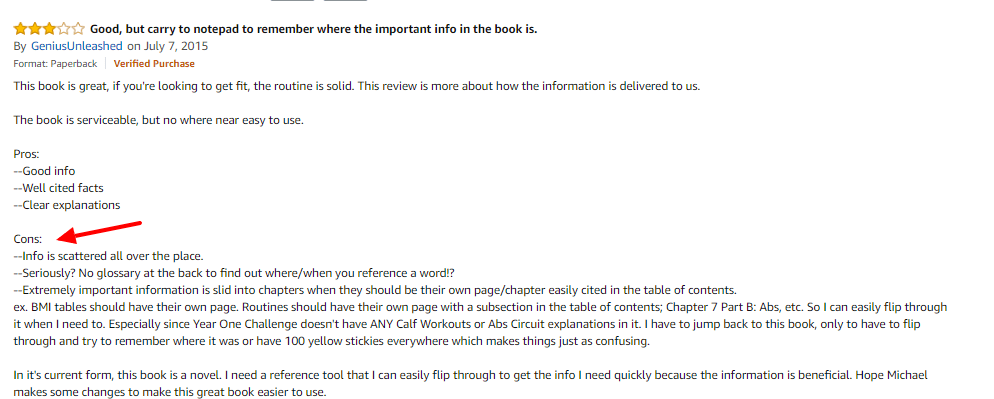
The second reader was upset because the information was poorly arranged. You couldn’t quickly reference any of the material.
From this exercise, we know strength training is popular and whatever we produce needs to be simple to implement and easy to reference.
- Based on what people are already engaging with on your website
There’s no need to go far. There are pages on your website that are already performing well. Take advantage of them. Log into you’re Google Analytics account. If you don’t have it set up, go do that – it’s free.
Once you’re on the main page, look to the right sidebar.
Click on Behavior -> All Pages
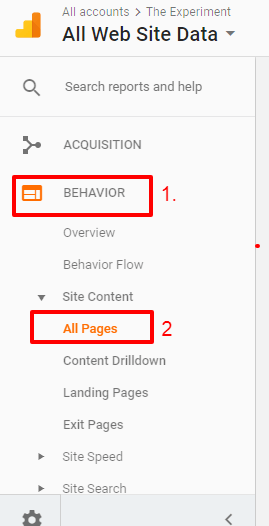
This will show you the most popular pages on your website by page views.

This is a goldmine of ideas for what you could turn into lead magnets (you can also use this for product ideas but that’s a story for another day).
We could create lead magnets about psychology, updated online business ideas, and writing tips.
You can also take it a step further by arranging your most popular content by category. That way, if your website covers many topics, you’ll be able to craft lead magnets for every section.
Alright, go through the exercises above and come up with a few lead magnet ideas. Once you’re done, choose one to work on.
Write the copy for it
Before you create your lead magnet, you need to write the copy for it?
Why?
It seems like a backward approach. Well, this will focus you. I have a tendency to create and keep on creating. I don’t have a filter. My articles are looong. This sentence rounds out fifteen hundred words.
Writing the copy first lets you identify the major benefit you’re offering upfront.
Instead of making it then trying to figure out how to position it, you position it then make it according to those guidelines.
In general, the copy for your lead magnet should have three things:
Headline: Your big promise of course. Check out this post for headline formulas you can use.
Subheading: Explain a bit more about your big promise.
Call to action: The call to action for your lead magnet should be action-oriented. Instead of “subscribe,” use “get the checklist.” Though we’re not fans of NLP and many of the principles they use, a more descriptive action-oriented call to action is always a plus.
Create and design it
Imagine you just gave your contact information in exchange for a checklist, or Ebook, or mini training series. At the end of the day, you want to get something useful. If, on the other hand, it sucks, will you be willing to continue the interaction with that brand?
Speaking of valuable content formats, creating an Ebook has become a go-to strategy for establishing authority in your space. The beauty of an Ebook lies in its versatility – you can pack it with in-depth insights, beautiful visuals, and actionable tips that readers can refer back to whenever they need.
What’s really cool is how a well-crafted Ebook can position you as the expert while quietly nurturing leads who aren’t quite ready to buy.
Not likely.
Your lead magnet doesn’t need to be a fully-fledged book or five thirty-minute videos. No one will read or watch that. What it does need to do is solve the problem it says it will solve.
Remember, this is the beginning of the interaction people have with your brand. You want to make a good impression. That’s not done by saving a three-paragraph word file as a PDF.
Create the shortest possible resource that fully answers the question. Your subscribers will thank you.
The other part of the puzzle is design. You don’t need to hire a designer. You do need to make it look presentable.
There are a few tools to speed up that process.
Beacon.by
![]()
Beacon is a lifesaver because you can import your blog posts into the app. They have a WordPress plugin too.
Canva.com
We use Canva for more than just PDFs, you can create most of your marketing material here. They have dedicated layouts for Ebooks and other design collateral like social media posts and featured images.
To speed up your process, make a template for lead magnets you’ll create on a regular basis. For an even more engaging presentation, consider transforming your Canva-designed ebooks into a flipbook format, which can significantly enhance reader interaction and retention.
What’s really cool about creating an engaging presentation these days is how it’s all about storytelling and not just dumping information on people. We’ve found that the best presentations are the ones that feel more like a conversation and less like a lecture – where each slide is almost like a chapter that pulls you deeper into the narrative.
The magic happens when you can take complex ideas and break them down in a way that makes your audience lean in and think, “Wow, I never thought about it like that before.” And let’s be real, in a world where everyone’s attention is pulled in a million directions, an engaging presentation isn’t just nice to have – it’s your secret weapon for actually getting your message to stick.
Sign up for a Canva account. You’ll be taken to their dashboard, click on the more button to the far left.
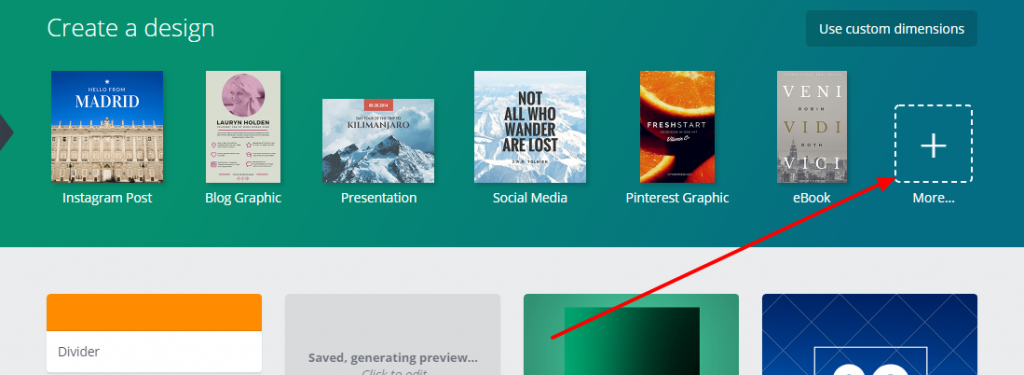
Scroll down until you see the heading “Blogging and Ebooks,” click on book cover.
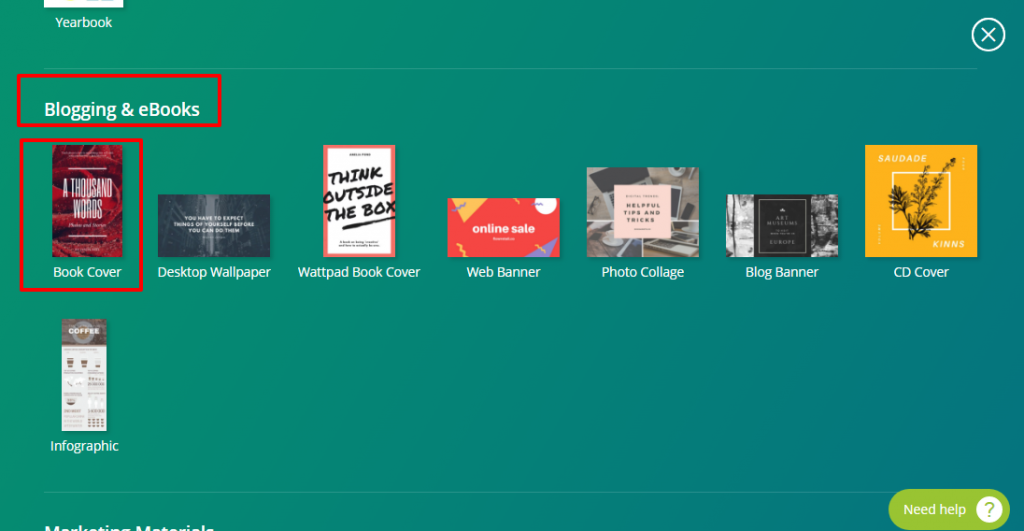
Once you’re there, play around with the options to customize your book cover or choose one of their free templates. This is what I created in roughly seven minutes.
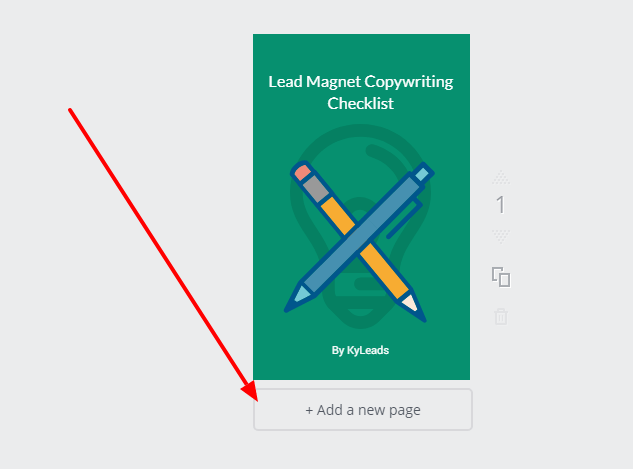
It’s not perfect but it’s much better than a Word file exported as a PDF. Once you’re done, just add a new page and copy your content in.
Note: this is ideal for short lead magnets. You can’t use it to design a full book because it gets ungainly after too many pages. We use them for short projects.
Release it to the wild
After everything, it’s time to publish your baby. The next question is “Where do I place it?”
The short answer is – it depends. There are a few obvious places which we’ll explore:
- Site wide Lightbox Popup
Site wide lead magnets are common and work best when your website is focused on a specific topic. A lifestyle blog that touches on travel, cooking, and fitness would find it harder to use a site wide lead magnet than a copywriting website.
Even if your site-wide lead magnet isn’t obvious, that doesn’t mean you shouldn’t try to find one.

Forzieri chooses to go with a site-wide lead magnet that gives away a lot of value – $1,500 to be exact. While we tend to shy away from contests because it can attract the wrong kind of subscriber, they work well if you know what you’re doing.
They use imagery and clear instructions on their lead magnet which leaves little room for doubt.
- Sidebar
Sidebars have notoriously bad conversions. If you must have them, you might as well make the most of them. Though Latin languages go from left to right and that’s the way we interact with web pages, it doesn’t make much of difference.
Your sidebar can be on the left or the right. What’ important is what you put in the sidebar.
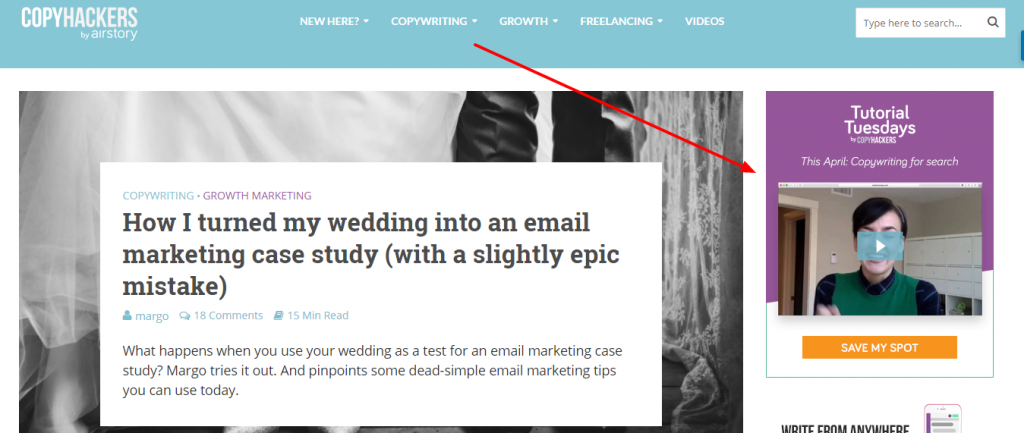
Joanna from Copyhackers uses that real estate to advertise Tutorial Tuesdays. A free webinar on a different topic every week. They’re usually pretty good.
In addition to promoting Tutorial Tuesdays, Joanna from Copyhackers uses her advertising space to introduce a captivating and insightful “webinar topic of the week.” In addition to promoting Tutorial Tuesdays, Joanna from Copyhackers uses her advertising space to introduce a captivating and insightful “webinar topic of the week.”
This allows participants to experience a variety of engaging webinars focused on different subjects, making it an excellent opportunity to explore new areas of interest and enhance their knowledge. So, it’s a golden opportunity to quench your thirst for knowledge and discover new passions in the most engaging and interactive way.
Webinars are incredibly effective for engaging with your audience and providing valuable insights. When it comes to lead magnets in the middle of the funnel, hosting a webinar on a relevant and captivating topic can be highly impactful.
A webinar lets you present in-depth information, share your expertise, and interact with participants in real time.
Choose a webinar topic that addresses a specific pain point or offers valuable knowledge to your target audience, ensuring that it aligns with their interests and needs.
By offering a webinar as a lead magnet, you can attract engaged prospects eager to learn from your expertise.
It’s sparse on supporting text but stands out against the page and has a strong call to action.
- Content-specific AKA content upgrades
Content upgrades became popular a few years ago and have been working ever since. They’re lead magnets that extend the usefulness of a specific post.
Brian Dean of Backlinko used content upgrades to increase conversions by 785% without too much effort.
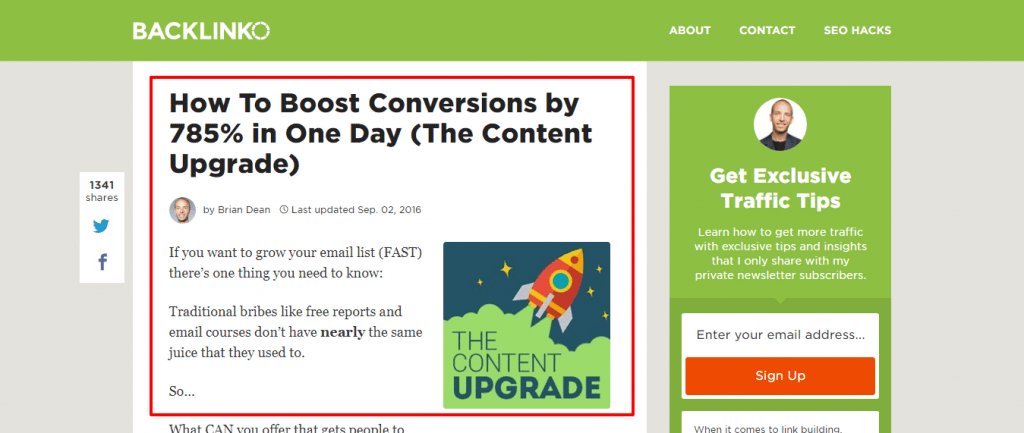
Remember, content upgrades are post specific. They would be out of place on other pages of your website. In lieu of a content upgrade, you can put a lead magnet at the end of the post or below the menu bar. Both of these positions tend to work well.
Examples of Lead Magnets that are crushing it
Now that we’ve gone through everything you need to know to create a compelling lead magnet, let’s look at real-life examples.
I’ll walk through what I think each one is doing well. From there, you can apply the same learnings to your efforts and reap the rewards.
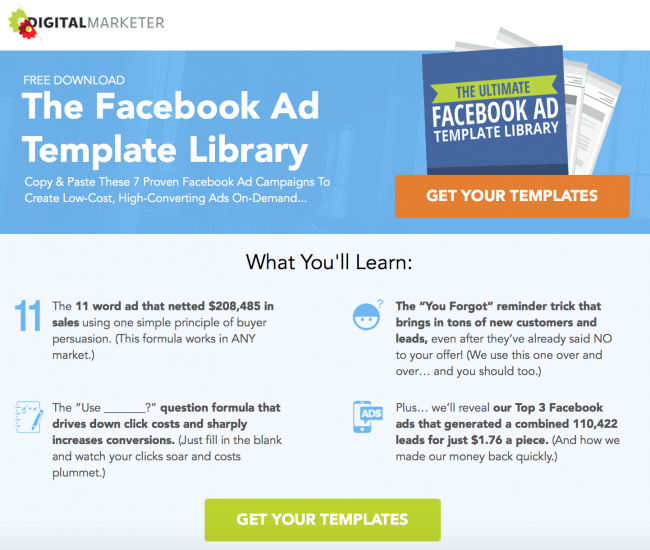
In a semi-famous lead magnet, Digital Marketer got over 35,000 leads in sixty days. Now, Digital Marketer is a large website. Though the lead magnet is on point, the results are a function of their traffic numbers. What’s more important to you are the principles behind their lead magnet.
They have a compelling title that speaks to the need for a specific group of people. They followed it up with not only a strong sub headline but explanatory bullets that drove the offer home. They rounded out their lead magnet with a strong action-oriented call to action.
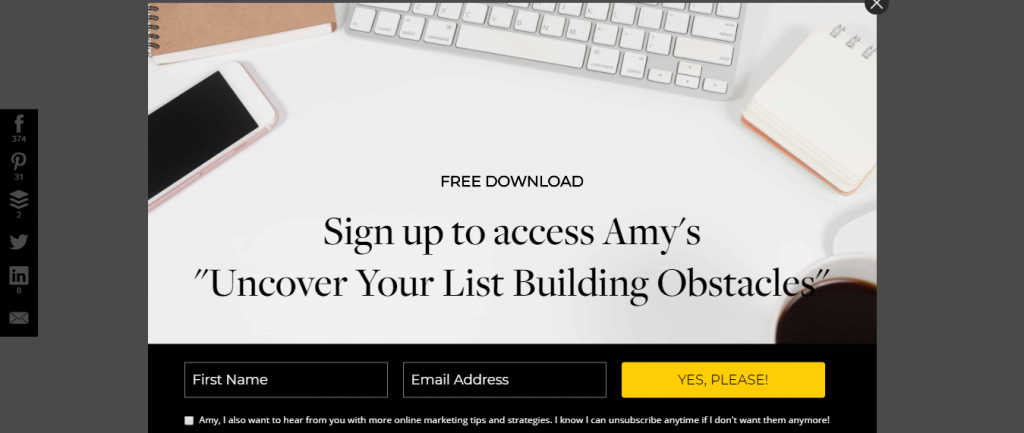
This lead magnet from Amy Porterfield only shows up on a specific page. The post that introduces a podcast episode focused on list building. This lightbox is, in essence, a well-designed content upgrade. It’s the natural progression to the podcast episode and comes off as a no brainer to most people viewing the page.
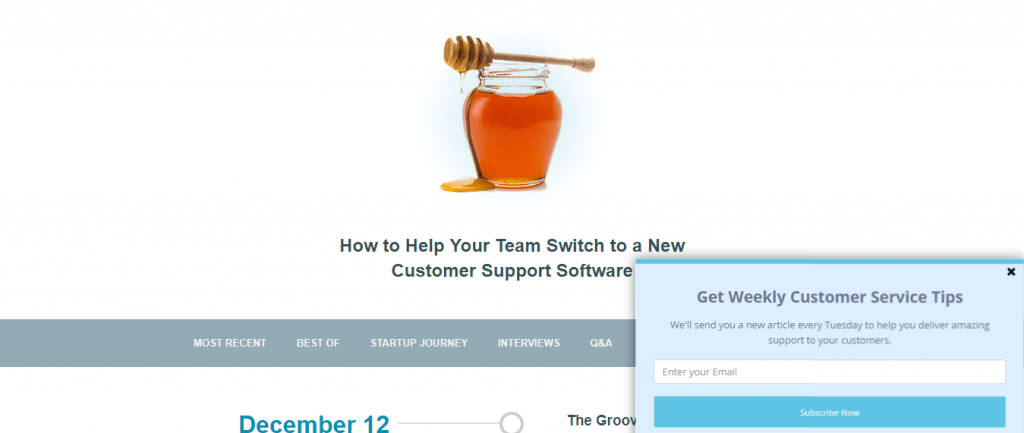
The Groove blog is divided into multiple sections. They have a standard customer service section that’s geared towards helping their customers get the most out of their product. They also have a blog that focuses on the lessons they’ve learned as a startup.
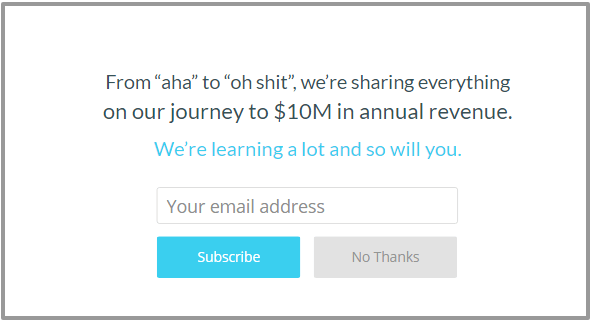
The first lead magnet focuses on its customer service blog. The second one, the one responsible for the majority of their subscribers, focuses on the lessons they share and what you stand to gain if you join. It’s an easy sell to business owners.
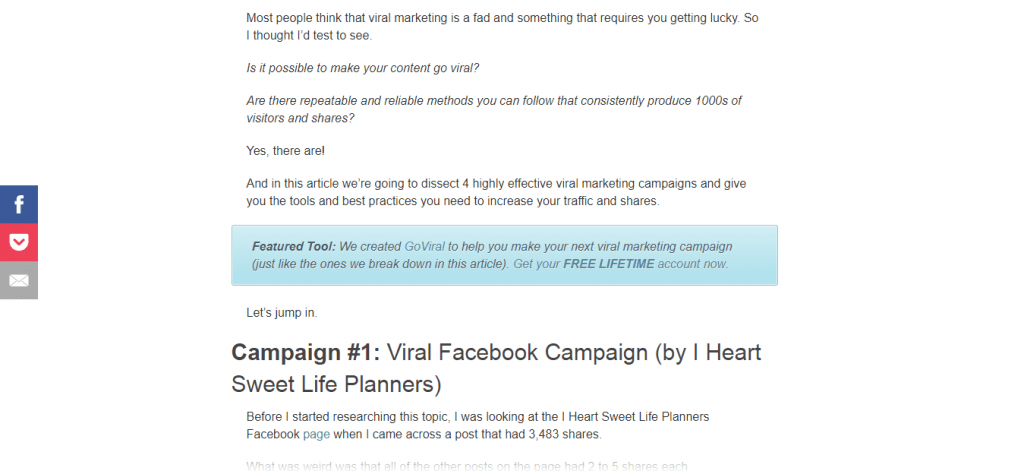
Bryan Harris runs the popular VideoFruit blog. He started off making videos for other brands then pivoted to focus on list building. One of the most powerful techniques he’s employed on his website is content upgrades.
He has them on the majority of his pages. It’s no accident that he gets conversion rates of over twenty percent on many of his content upgrades. The content upgrade in the post above is so compelling because it’s a piece of software that allows you to give out ethical bribes.
Firstly, it’s dialed into the post. Secondly, it’s free. Who doesn’t love free useful software?
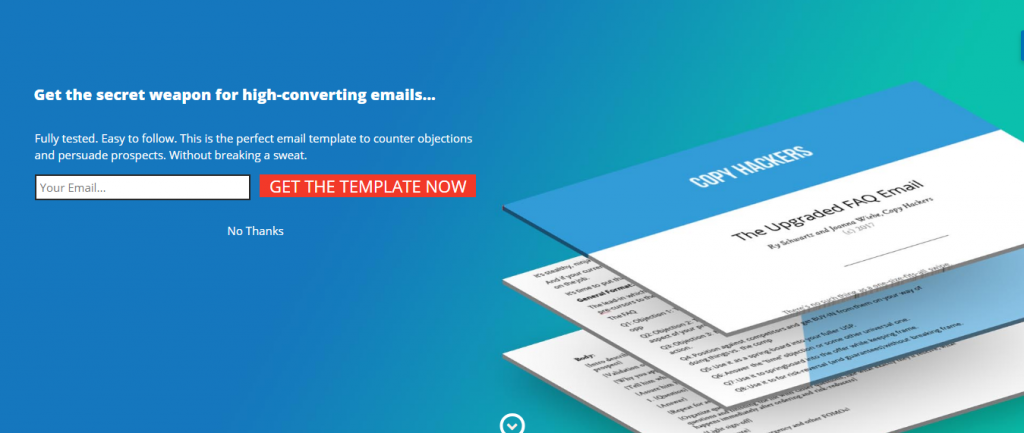
Copyhackers has made a second appearance in this post. Their lead magnet works well because it’s on every page of their website and appears as a full-page modal. This may turn some people off but there’s no denying its effectiveness.
On top of that, they use powerful language in their copy. “Secret weapon” “high-converting” “fully tested” all give you the impression that these email templates are on the money. The button itself is worded to promote action.
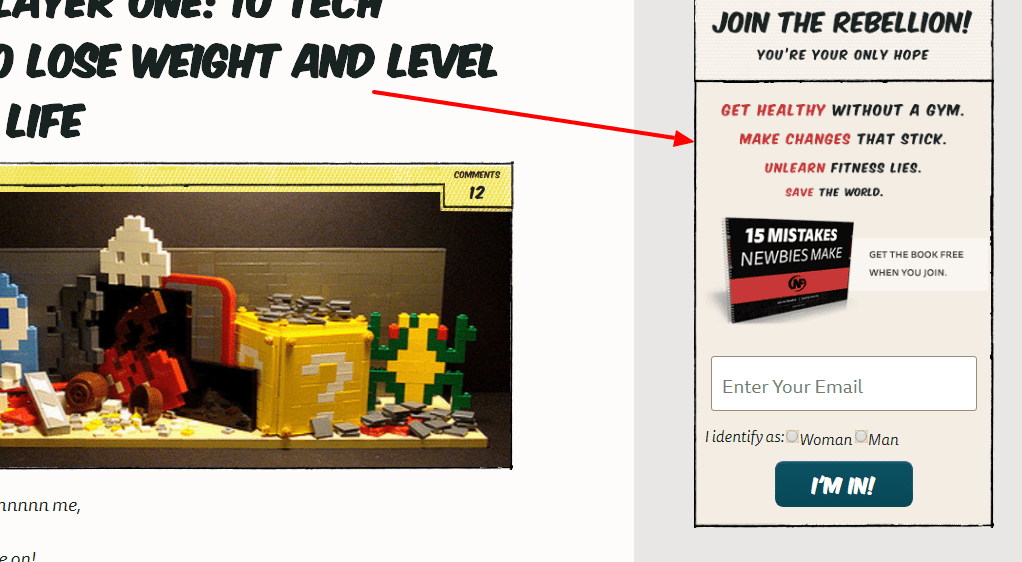
NerdFitness instills a sense of community from the beginning by leading with “Join the Rebellion.” After that, the copy goes on to highlight the main takeaways in a series of bullets.
To top it off, they offer a book that’ll reveal some things you may be doing wrong right now.
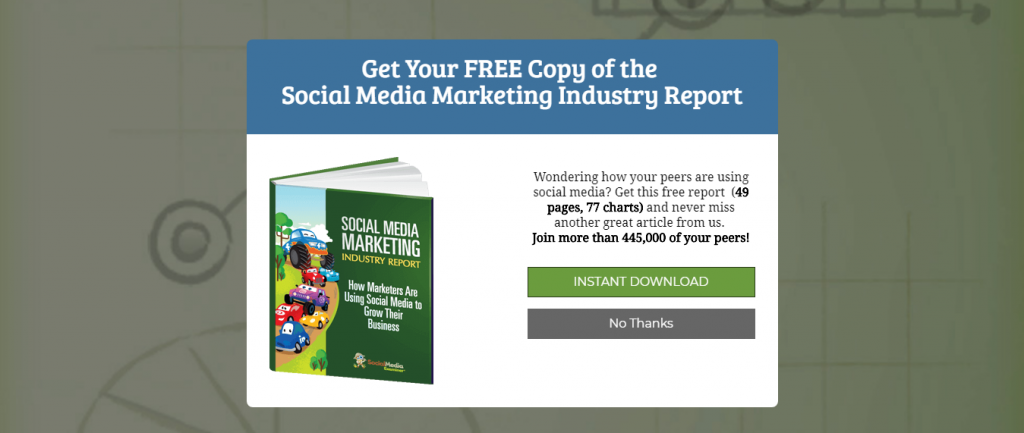
Social Media Examiner is one of the most popular blogs in the social media space. They’ve been performing an annual report on the trends affecting social media and its impact on your business.
That report is full of compelling data and insights. The lead magnet is a free copy of the report. Their copy highlights exactly how many pages it has, how many charts, and the massive number of people already receiving it. They’re using specificity the right way.
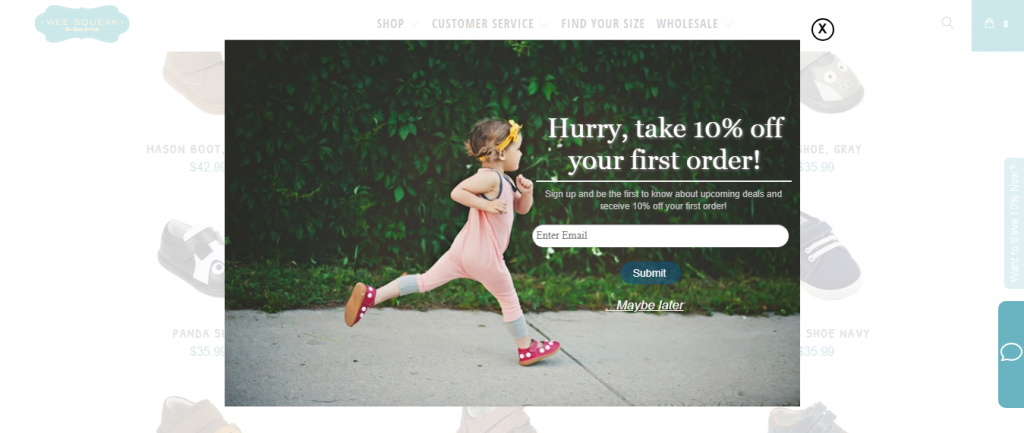
In this example from WeeSqueak, the use of imagery is on point. First, some context about the company. They’re an eCommerce brand that specializes in unique shoes for toddlers. This lightbox appeared when I was about to leave the page.
They use it to catch my attention before going. The copy tells me to hurry and the image shows a toddler running. Nice touch. The offer is also direct. Sign up for our mailing list and you get 10% off your first order. You’re also put in a position to learn more about deals.
I may get something for my niece.
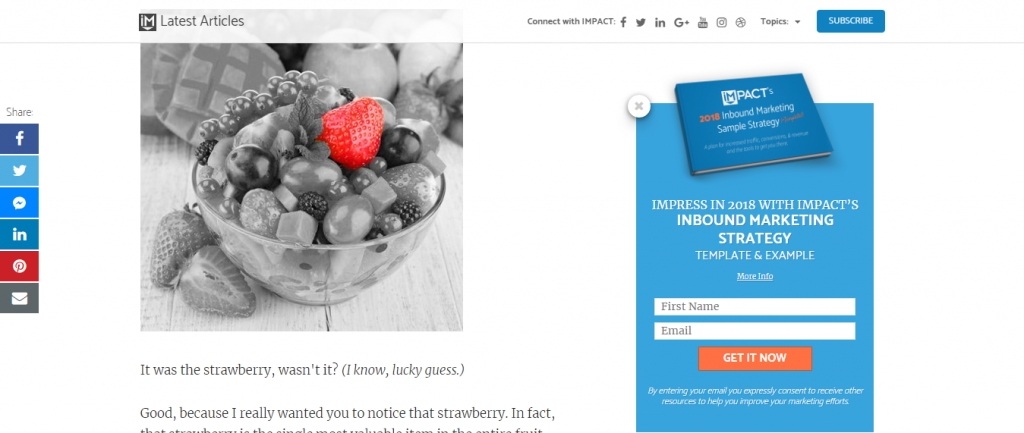
Impactbnd has a simple sidebar opt-in that’s well designed. They show you what you’re getting and use interesting copy like “impress.” They also highlight the fact that you’ll get templates and examples inside.
There’s a button labeled more info that takes you to the following landing page:
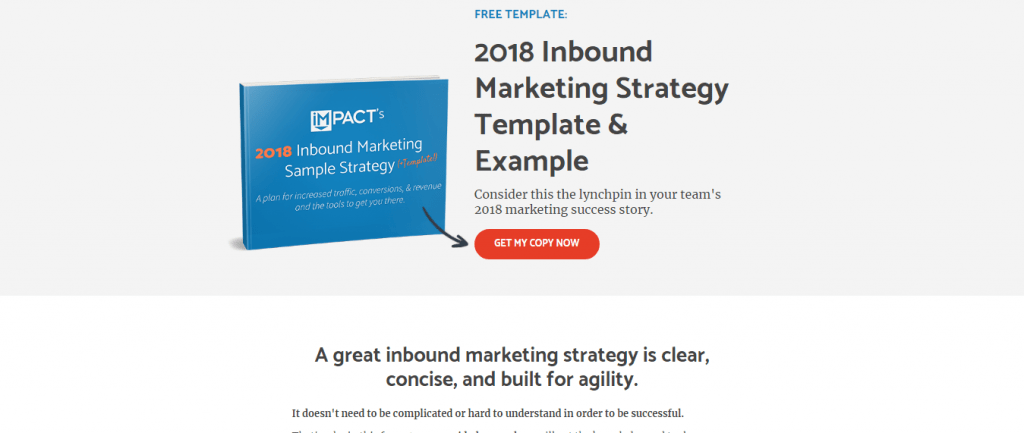
With these examples, you should have a solid idea of how to position your lead magnets and the designs that are working right now.
Conclusion
Lead magnets, without a doubt, are an essential part of growing your email list. A single lead magnet won’t work for every person that visits your website. You need to craft multiple lead magnets to cater to people at different stages of the customer lifecycle.
Once you have a solid idea of what to make, write the copy for the offer, create the lead magnet, and release it to the wild. Make sure it’s in a place where it’ll be seen often then test it until you get a conversion rate you’re happy with.
Jump in the comments and let us know about any great lead magnets you’ve seen while wandering the web.